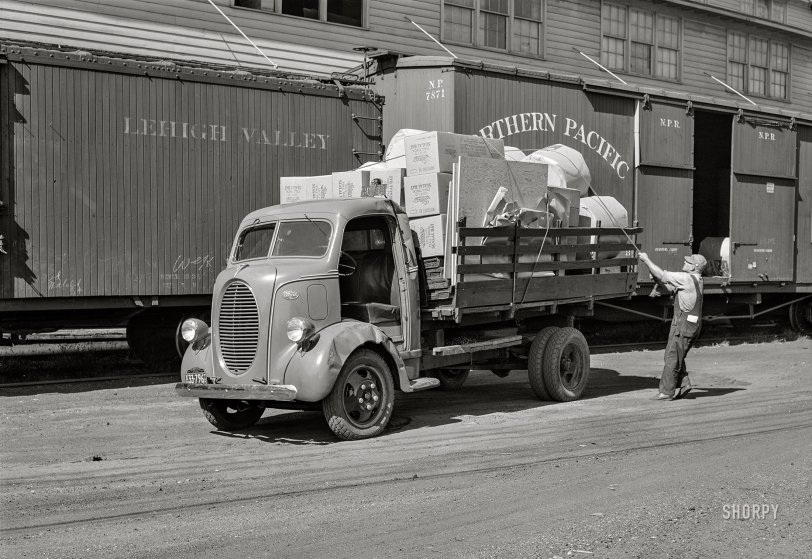


Framed or unframed, desk size to sofa size, printed by us in Arizona and Alabama since 2007. Explore now.
Shorpy is funded by you. Patreon contributors get an ad-free experience.
Learn more.

- Lofty addition
- In 1912
- Keenan Building
- Six years old
- Taken from the P.J. McArdle Roadway?
- It stood only 47 years
- Three track mind
- Incline to the right
- Reach for the sky, 1912 style
- No clean sweep
- Same Job Title, Same Face
- Sadly Lost
- Beautiful ...
- Where you get your kicks
- Aim High
- Pueblo Revival sisters
- Pueblo Neoclassicism
- Milk Man
- Regional dialect.
- Spielberg's inspiration
- Great Photo
- Loaf Story
- Do you still have the Rakes category?
- Could almost be a scene from the 1957 movie 'Hell Drivers'
- The Wages of Fear.
- Conspicuous by their absence
- Got Milk?
- All that aluminum
- No lefties
- Smoke 'em if you've got 'em
Print Emporium
Twin Cities Trucker: 1939

September 1939. "Truck driver who operates between Twin Cities and radius of 150 miles tying in load. Minneapolis, Minnesota." Medium format acetate negative by John Vachon for the Farm Security Administration. View full size.
Independent Trucker
This is a good example of how independent owner-operated trucking worked back then. Licensed and regulated trucking companies and union drivers would have referred to him as a "gypsy."
If you had a large enough freight shipment, it would be much cheaper to just "rent" a boxcar from the railroad and be responsible for loading and unloading it yourself. The railroad would park the car on a "public" or "team" track, and you would "release" it to the railroad when it was loaded and ready to move, and when unloaded at the destination and available for reassignment. You had a limited time to hold the car at each end without incurring extra charges called "demurrage." You could save even more by having a one-person delivery service like this one to unload it for you if you couldn't do it yourself.
My great-grandparents used this method circa 1895, when they moved 75 miles from Darlington to Columbia, South Carolina. It was the only way to do it then, since roads (and trucks) did not yet exist.
Pre Aerosol Graffiti
I see the street artist of the time had to use sidewalk chalk for their tagging. Or, are those rail hobo telegraph messages?
[Routing designations scrawled by railyard switchmen. -Dave]
Trucker's Hitch?
I'm curious how the tension on this load is maintained. Is it possible that a "trucker's hitch" is applied on the opposite side of the vehicle?
Old boxcars
A couple of elderly cars for a 1939 photo. Believe it or not, the one on the right is probably older -- you can see the metal “truss rods” under the floor of the car, a tensioning system to strengthen the wood floor. Unless it had steel members added, most of that car’s structural members are probably wood, while the car on the left lacks the truss, and probably has a steel underframe.
I love the arched “Northern Pacific” lettering -- the kind of thing that vanished as wages rose, because it was harder to do with a single stencil.
Toasty
I'm sure that new Minnesota homeowners will appreciate those "Full Thick Sealal Bats" come wintertime.
He's got a story to tell
If only he could tell about that time he lost the cab's door.
Insulation for Minnesota winters
These are Gimco rock wool insulated batts. Rock wool has traditionally been made by melting down basalt stone and recycled slag from steel mills.
Interesting article about it here:
https://www.familyhandyman.com/walls/mineral-wool-insulation-is-making-a...
Safety Cab
When your brakes are unreliable, it's important to be able to jump out quickly!
























On Shorpy:
Today’s Top 5